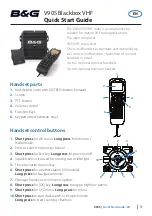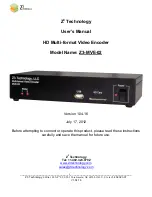
14
INSTALLATION AND CONNECTIONS
System Installation
After unpacking the unit, locating it in a place with ade-
quate vantilation and placing it on a solid surface capable
of supporting its weight, you will need to make the con-
nections to your audio and video equipment.
IMPORTANT NOTE:
For your personal safety and to
avoid possible damage to your equipment and speakers,
it is always good practice to turn off and unplug the AVR
and ALL source equipment from the AC output before
making any audio or video system connections.
Audio Equipment Connections
We recommend that you use high-quality interconnect
cables when making connections to source equipment
and recorders to preserve the integrity of the signals.
1. Connect the analog output of a CD player to the
CD Audio Inputs
.
NOTE:
When the CD player has both fixed and vari-
able audio outputs, it is best to use the fixed output
unless you find that the input to the receiver is so low
that the sound is noisy, or so high that it is distorted.
2. Connect the analog Play/Out jacks of a cassette
deck, MD, CD-R or other audio recorder to the
Tape
Input Jacks
. Connect the analog Record/In
jacks on the recorder to the
Tape Output Jacks
on the AVR 525.
3. Connect the output of any digital sources such as
such as a CD or DVD changer or player, advanced
video game, a digital satellite receiver, HDTV tuner or
digital cable set-top box or the output of a compati-
ble computer sound card to the
Optical
and
Coaxial Digital Audio Inputs
&(
.
4. Connect the coaxial or optical
Digital Audio Outputs
ik
on the rear panel of the AVR 525 to the matching
digital input connections on a CD-R or MiniDisc recorder.
5. Assemble the AM Loop Antenna supplied with the
unit. Connect it to the
AM
and
GND Screw
Terminals
¡
.
6. Connect the supplied FM antenna to the
FM
(75-
ohm)
Connection
™
. The FM antenna may be an
external roof antenna, an inside powered or wire-lead
antenna or a connection from a cable TV system. If
the antenna or connection uses 300-ohm twin-lead
cable, you must use the 300-ohm-to-75-ohm adapter
supplied with the unit to make the connection.
7. Connect the front, center, surround and surround
back speaker outputs
§¶ª‚
to the respective
speakers.
To ensure that all the audio signals are carried to your
speakers without loss of clarity or resolution, we sug-
gest that you use high-quality speaker cable. Many
brands of cable are available and the choice of cable
may be influenced by the distance between your
speakers and the receiver, the type of speakers you
use, personal preferences and other factors. Your deal-
er or installer is a valuable resource to consult in
selecting the proper cable.
Regardless of the brand of cable selected, we recom-
mend that you use a cable constructed of multistrand
copper with a gauge of 14 or smaller. Remember that
in specifying cable, the lower the number, the thicker
the cable.
Cable with a gauge of 16 may be used for short runs
of less than ten feet. We do not recommend that you
use cables with an AWG equivalent of 18 or higher,
due to the power loss and degradation in performance
that will occur.
Cables that are run inside walls should have the appro-
priate markings to indicate listing with UL, CSA or other
appropriate testing agency standards. Questions about
running cables inside walls should be referred to your
installer or a licensed electrician who is familiar with
the NEC and/or the applicable local building codes in
your area.
When connecting wires to the speakers, be certain to
observe proper polarity. Note that the positive (+) ter-
minal of each speaker connection now carries a spe-
cific color code as noted on page 8. However, most
speakers still use a red terminal for the positive (+)
connection. Connect the “negative” or “black” wire
to the same terminal on both the receiver and the
speaker.
NOTE:
While most speaker manufacturers adhere to
an industry convention of using black terminals for
negative and red ones for positive, some may vary
from this configuration. To ensure proper phase and
optimal performance, consult the identification plate on
your speaker or the speaker’s manual to verify polarity.
If you do not know the polarity of your speaker, ask
your dealer for advice before proceeding, or consult
the speaker’s manufacturer.
We also recommend that the length of cable used
to connect speaker pairs be identical. For example,
use the same length piece of cable to connect the
front-left and front-right or surround-left and sur-
round-right speakers, even if the speakers are a dif-
ferent distance from the AVR 525.
8. Connections to a subwoofer are normally made via
a line-level audio connection from the
Subwoofer
Output
¢
to the line-level input of a subwoofer with
a built-in amplifier. When a passive subwoofer is used,
the connection first goes to a power amplifier, which
will be connected to one or more subwoofer speakers.
If you are using a powered subwoofer that does not
have line-level input connections, follow the instruc-
tions furnished with the speaker for connection infor-
mation.
9. If an external multichannel audio source with 5.1
outputs such as an external digital processor/decoder,
DVD-Audio or SACD player is used, connect the
outputs of that device to the
8-Channel Direct
Inputs
.
Video Equipment Connections
Video equipment is connected in the same manner as
audio components. Again, the use of high-quality inter-
connect cables is recommended to preserve signal
quality.
1. Connect a VCR’s or other video source’s audio and
video Play/Out jacks to the
Video 1/Video 2 Audio
and Video Input Jacks
fl°
on the rear
panel. The Audio and Video Record/In jacks on the
VCR should be connected to the
Video 1/Video 2
Audio and Video Output Jacks
‡·
on
the AVR 525.
2. Connect the analog audio and video outputs of a
satellite receiver, cable TV converter or television set or
any other video source to the
VIdeo 3 Audio and
Video Input Jacks
a
.
3. Connect the analog audio and video outputs of a
DVD or laser disc player to the
DVD Audio and
Video Inputs
fi
.
4. Connect the digital audio outputs of a DVD player,
satellite receiver, cable box or HDTV converter to the
appropriate
Optical
or
Coaxial Digital Inputs
&(
.
5. Connect the
Video Monitor Output
›
jacks on
the receiver to the composite or S-Video input of your
television monitor or video projector.
6. If your DVD player and monitor both have compo-
nent video connections, connect the component out-
puts of the DVD player to the
DVD Component
Video Inputs
c
. Even when component video con-
nections are used, the audio connections should still
be made to either the analog
DVD Audio Inputs
or any of the
Optical
or
Coaxial Digital Input Jacks
k
.
7. If other devices with component video outputs are
available, connect it to the
Video 2 Component
Video Inputs
d
. The audio connections for this
33
32
36
33
32
42
41
38
39
37
40
36
33
35
34
31
AVR525
harman/kardon
14
Summary of Contents for AVR 525
Page 18: ...18...
Page 20: ...VR71 FRONT L CH VR73 SURROUND L CH P804 FRONT R CH P802 SURROUND R CH AVR525 harman kardon 20...
Page 21: ...VR74 FRONT R CH VR72 SURROUND R CH AVR525 harman kardon 21...
Page 23: ...P309 VR51 BACK SURROUND R CH AVR525 harman kardon 23...
Page 33: ...AVR525 harman kardon 33...
Page 92: ...AVR525 harman kardon 92...
Page 93: ...AVR525 harman kardon 93...
Page 94: ...AVR525 harman kardon 94...
Page 95: ...AVR525 harman kardon 95...
Page 96: ...AVR525 harman kardon 96...
Page 97: ...AVR525 harman kardon 97...
Page 98: ...AVR525 harman kardon 98...
Page 99: ...AVR525 harman kardon 99...
Page 100: ...AVR525 harman kardon 100...
Page 101: ...AVR525 harman kardon 101...
Page 102: ...AVR525 harman kardon 102...
Page 103: ...AVR525 harman kardon 103...
Page 104: ...AVR525 harman kardon 104...
Page 105: ...AVR525 harman kardon 105...
Page 106: ...AVR525 harman kardon 106...
Page 107: ...AVR525 harman kardon 107...
Page 108: ...AVR525 harman kardon 108...
Page 114: ...AVR525 harman kardon 114...
Page 115: ...AVR525 harman kardon 115...
Page 124: ...AVR525 harman kardon 124...
Page 125: ...AVR525 harman kardon 125...
Page 126: ...AVR525 harman kardon 126...
Page 127: ...AVR525 harman kardon 127...
Page 128: ...AVR525 harman kardon 128...
Page 129: ...AVR525 harman kardon 129...
Page 130: ...AVR525 harman kardon 130...
Page 131: ...AVR525 harman kardon 131...
Page 132: ...AVR525 harman kardon 132...
Page 133: ...AVR525 harman kardon 133...
Page 134: ...AVR525 harman kardon 134...
Page 137: ...AVR525 harman kardon 137...
Page 138: ...AVR525 harman kardon 138...
Page 140: ...AVR525 harman kardon 140...
Page 141: ...AVR525 harman kardon 141...
Page 142: ...AVR525 harman kardon 142...
Page 143: ...AVR525 harman kardon 143...
Page 144: ...AVR525 harman kardon 144...
Page 145: ...AVR525 harman kardon 145...
Page 146: ...AVR525 harman kardon 146...
Page 147: ...AVR525 harman kardon 147...
Page 148: ...AVR525 harman kardon 148...
Page 149: ...AVR525 harman kardon 149...
Page 150: ...AVR525 harman kardon 150...
Page 151: ...AVR525 harman kardon 151...
Page 152: ...AVR525 harman kardon 152...
Page 153: ...AVR525 harman kardon 153...
Page 154: ...AVR525 harman kardon 154...
Page 160: ...AVR525 harman kardon 160...
Page 161: ...AVR525 harman kardon 161...
Page 162: ...AVR525 harman kardon 162...
Page 163: ...M4A3 32 10VC 12VI AVR525 harman kardon 163...
Page 164: ...M4A3 32 10VC 12VI AVR525 harman kardon 164...
Page 165: ...AVR525 harman kardon 165...
Page 166: ...AVR525 harman kardon 166...
Page 167: ...167...
Page 168: ...AVR525 harman kardon 168...
Page 169: ...169...
Page 170: ...170...
Page 171: ...AVR525 harman kardon 171...
Page 172: ...172...
Page 173: ...AVR525 harman kardon 173...
Page 174: ...AVR525 harman kardon 174...
Page 175: ...AVR525 harman kardon 175...
Page 176: ...176...
Page 177: ...AVR525 harman kardon 177...
Page 178: ...AVR525 harman kardon 178...
Page 179: ...179...
Page 180: ...AVR525 harman kardon 180...
Page 181: ...181...
Page 182: ...AVR525 harman kardon 182...
Page 183: ...AVR525 harman kardon 183...
Page 184: ...AVR525 harman kardon 184...
Page 185: ...185...
Page 186: ...186...
Page 187: ...AVR525 harman kardon 187...















































